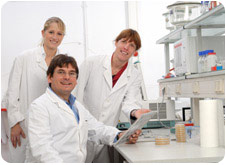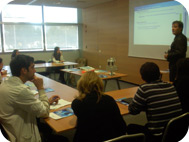LabCluster
Tour "Transcriptomic, Single-cell
Mardi 23 mai 2023 • 9h00 - 12h45 |
|
La participation est gratuite sur inscription Il est possible de s'inscrire à la totalité de la matinée ou seulement à une ou plusieurs conférences.Evénement organisé dans le respect des mesures sanitaires et des gestes barrières. |
|||||
| Cliquez ici pour vous inscrire |
|
||||
Thème de la demi-journée :
| TRANSCRIPTOMIC,
SINGLE-CELL, SPATIAL BIOLOGY |
||||||
Programme :
| |
Accueil café dès 8H30 9H00- 9H30 10X Genomics Explore new pathways in tissue biology with Visium CytAssist and Xenium in situ platforms Assessing gene expression with morphological context is critical to our understanding of biology and the progression of disease. Historically, it has been challenging to spatially interrogate complex heterogeneous tissues in a high-throughput manner, especially without previously generated assumptions about the genes being expressed. With Visium Spatial products researchers can now map the whole transcriptome for entire H&E- or immunofluorescently stained fresh frozen or FFPE tissue sections with morphological context. And now with the Xenium platform you can get new insights into cellular structure and function by performing high-throughput mapping of 100s of RNA targets in their true tissue context. The platform includes a versatile and easy-to-use instrument, sensitive and specific chemistry, a diverse menu of customizable panels, and powerful visualization software.Join us to learn how Spatial products from 10x Genomics give you a comprehensive understanding of the relationships between cellular function, phenotype, interactions, and location in intact tissue sections. 9H30-10H00 Vizgen Decipher Tissue Complexity with Spatial Genomics: Single Cell Spatially Resolved Transcriptomic Imaging with MERSCOPE Powered by MERFISH Biological systems are made of numerous cell types, intricately organized to form functional tissues and organs. While recent advancements in genomics technologies have made it possible to characterize cell types through careful analysis of the transcriptome, they are unable to resolve how gene expression and cell types are spatially arranged. In this presentation, you will learn about Vizgen’s all-in-one in situ genomics platform MERSCOPE which enables the direct profiling of the spatial organization of intact tissue with genomic scale throughput. The instrument, the MERFISH chemistry and use cases will be presented as well. 10H-10H30 Nanostring Map your Tissue Sections at Any Scale with NanoString’s Spatial Platforms The CosMx Spatial Molecular Imager (SMI) is the first high-plex in situ analysis platform to provide spatial multiomics with formalin-fixed paraffin-embedded (FFPE) and fresh frozen (FF) tissue samples at cellular and subcellular resolution. CosMx SMI enables rapid quantification and visualization of up to 1,000 RNA and 64 validated protein analytes. It is the flexible, spatial single-cell imaging platform that will drive deeper insights for cell atlasing, tissue phenotyping, cell-cell interactions, cellular processes, and biomarker discovery. The GeoMx Digital Spatial Profiler (DSP) provides morphological context in spatial transcriptomics and spatial proteomics experiments from just one slide. From discovery to translational research, the GeoMx DSP is the most flexible and robust spatial biology solution designed to conform to your ever-changing research needs. 10H30-10H45 PAUSE 10H45 - 11H15 Scale Biosciences Unlocking the potential for single-cell sequencing at scale with combinatorial indexing Combinatorial indexing enables more complex single-cell experiments by increasing levels of sample multiplexing and cell throughput. Using the cell as the compartment, repeated rounds of splitting, indexing, and pooling are performed, enabling single-cell experiments with 100s of thousands to millions of cells, at a fraction of the current costs. In this presentation, we will introduce ScaleBio and the Single Cell RNA Sequencing Kit, which enables the indexing of up to 96 samples and 125,000 cells per experiment. We will also discuss our scATAC kit, as well as future application development. 11h15-11h45 Akoya Biosciences Single-Cell Spatial Phenotyping: Setting the pace of Discovery and Translational Research (Texte à venir) 11H45 - 12H15 Rarecyte Unlocking Spatial Biology with Orion™ Orion™ is a novel spatial biology platform enabling whole-slide immunofluorescence and same-section H&E imaging results for up to 20 biomarkers in a single-round tissue staining step. Orion imaging is achieved in less than 2 hours per sample, making the approach suitable for translational and clinical research. 12H15-12H45 Bio-Techne The RNAscope assay: the easiest way to perform robust spatial transcriptomic at the single cell level With RNAscope you can visualize any targets, on any tissues, in any species at the single cell level with a probability of success close to 100%. The technic is easy to implement in your lab as there is no need to buy costly equipments, no need to follow particular training and no need to optimize the protocol. In consequence, RNAscope is accessible to anybody ! In addition to the fact that the technique is specific and sensitive, it is possible to detect from 1 to 48 mRNAs and to combine mRNA and protein detection on the same biological sample (cells, FFPE/fixed-frozen/fresh frozen cross-sections, whole-mount, embryos…). The technic has been widely used during the past decade (1) as an alternative to IHC/IF (cells, pathogens, targets bio-distribution) (2) to confirm transcriptomic datas (qPCR, scRNAseq,…) and (3) to characterize the activation states of cells in situ. After the seminar, please come to see us at the Bio-Techne booth to discuss your research project. 14H00-14H45 Visite de la plateforme de cytométrie en flux et d’imagerie spatiale de l'Institut Curie |
||
|
Stands de démonstration et d'information toute la matinée. Venez nous rencontrer. |
|||

| Le nombre de places étant limité, il est fortement conseillé de s'inscrire à l'avance en cliquant ici |
|
|||
| Pour toute question ou demande d'information, cliquez ici | |
![]()



